The Curious Case of Ear Biting in Dogs
Dogs are known for their playful and sometimes mischievous behavior. They love to run, jump, and play tug-of-war. But have you ever noticed that sometimes dogs will bite each other’s ears?
It’s an interesting behavior that can be both playful and aggressive. In this article, we’ll explore why dogs bite each other’s ears and the importance of understanding this behavior.

Brief Explanation of Why Dogs Bite Each Other’s Ears
When two dogs interact with each other, they communicate through body language. This includes wagging tails, barking, growling, and yes – biting each other’s ears.
Ears are a key part of a dog’s body language because they can be used to signal different messages depending on the context. In some cases, ear biting is simply a form of play between dogs.
It can be a way for them to bond with each other and release some energy by engaging in physical activity. However, ear biting can also be a sign of dominance or aggression in certain situations.
Importance of Understanding This Behavior
As pet owners or dog lovers, it’s important to understand why dogs bite each other’s ears because it can help us better understand their behavior overall. Understanding ear-biting behavior helps us provide better care by decoding the communication signals they may be sending.
Additionally, knowing the context behind this behavior is crucial for preventing any potential harm from occurring between dogs when they play or interact with one another. By being aware of what constitutes playful versus harmful ear-biting behavior, we can intervene if necessary to keep our furry friends safe. So, let’s dive deeper into the topic and explore the different scenarios where ear biting can occur.
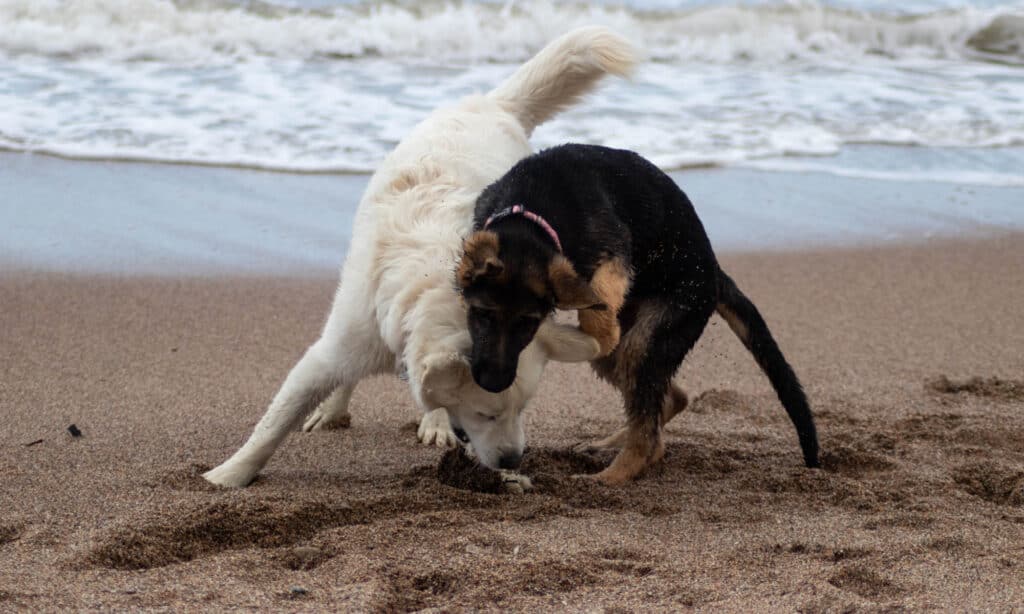
Communication through Body Language
Dogs use body language to communicate with each other
Dogs are social animals that rely on nonverbal communication to understand and interact with other dogs. They use their bodies to convey a wide range of emotions, including fear, aggression, playfulness, and submission.
Understanding dog body language is essential for responsible pet ownership and can help prevent conflicts between dogs. One of the most important parts of dog body language is the ears.
Dogs’ ears are highly mobile and can move independently of one another. They use their ears to express a variety of emotions, including happiness, fear, aggression, and curiosity.
Ears are a key part of this communication
When a dog is relaxed or happy, its ears will be in a natural position. The dog’s ear muscles will be relaxed as well. If the dog becomes curious or alert, it may raise its ears slightly while still keeping them in a natural position.
If the dog becomes fearful or submissive, it may lower its ears close to its head. This posture indicates that the dog is not a threat and is seeking protection.
When a dog wants to show dominance or aggression towards another dog, it may raise its ears up high while also raising its tail and standing tall on all fours. This posture shows that the dog is ready for action and may attack if necessary.
Dogs also use ear movements during playtime with other dogs. Playful ear biting can signal playfulness between dogs when they are engaging in healthy behavior patterns such as chasing each other or rolling around on the grass.
Understanding how dogs communicate through their body language is crucial for responsible pet ownership. Ears play an important role in this communication process by indicating various emotions such as happiness or fear. These can sometimes look similar so being able to identify subtle differences can make all the difference in keeping your dog safe and happy.
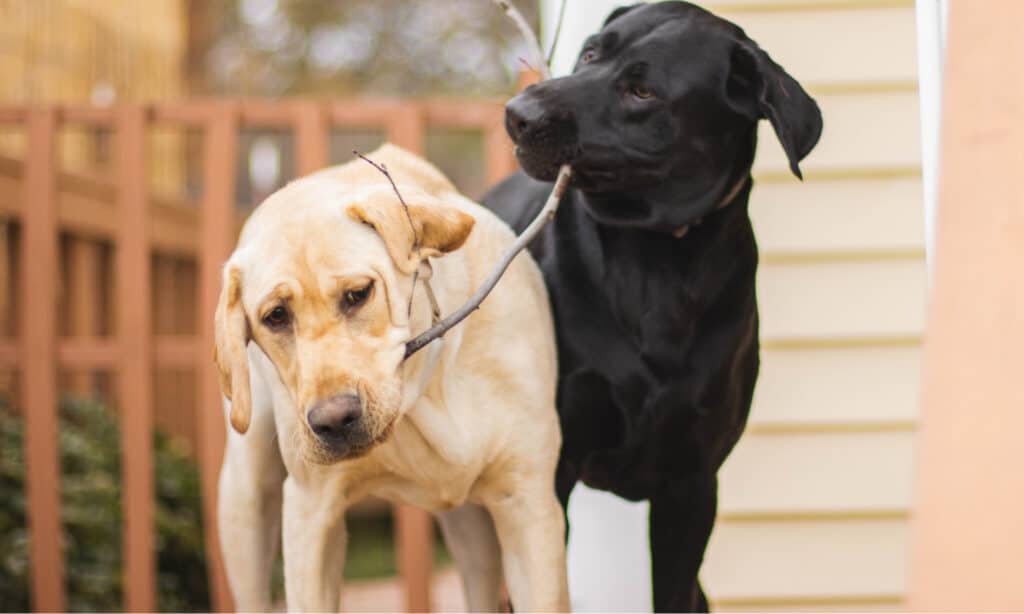
Playful Behavior
Dogs often play by biting each other’s ears
Dogs are social animals and thrive on interaction with other dogs, animals, and humans. Playful behavior is a crucial aspect of their socialization. Whether it’s between two dogs or between a dog and its human companion.
One of the ways in which dogs express their playful nature is by biting each other’s ears. This behavior is observed in puppies as young as six weeks old.
Puppies play with each other by chasing, wrestling, and biting each other’s ears. As they grow older, their playful behavior becomes more refined, but ear biting remains an essential part of it.
This behavior is usually harmless and playful
Ear biting in dogs is generally considered harmless and playful when it occurs during playtime. Dogs who engage in this type of behavior do so without any intent to harm or inflict pain on one another.
It’s important to note that just because ear biting during playtime isn’t harmful doesn’t mean that all types of ear biting are innocent. It can be challenging to differentiate between playful ear-biting and aggressive or dominant behavior.
Dogs usually have a way of communicating with each other through body language that indicates they are playing rather than fighting. Playful body language cues include wagging tails, relaxed postures, open mouths with relaxed facial expressions.
If you observe these signs during ear-biting playtime sessions among your dogs or those at the dog park, then there’s no need for concern. Ear-biting is an integral part of socialization for dogs from puppyhood through adulthood.
This activity helps them develop important communication skills while having fun at the same time. If you own multiple dogs or visit dog parks regularly where your pet interacts with others, watching how they communicate can help ensure that what appears to be simple fun really is just that – and not something more sinister.
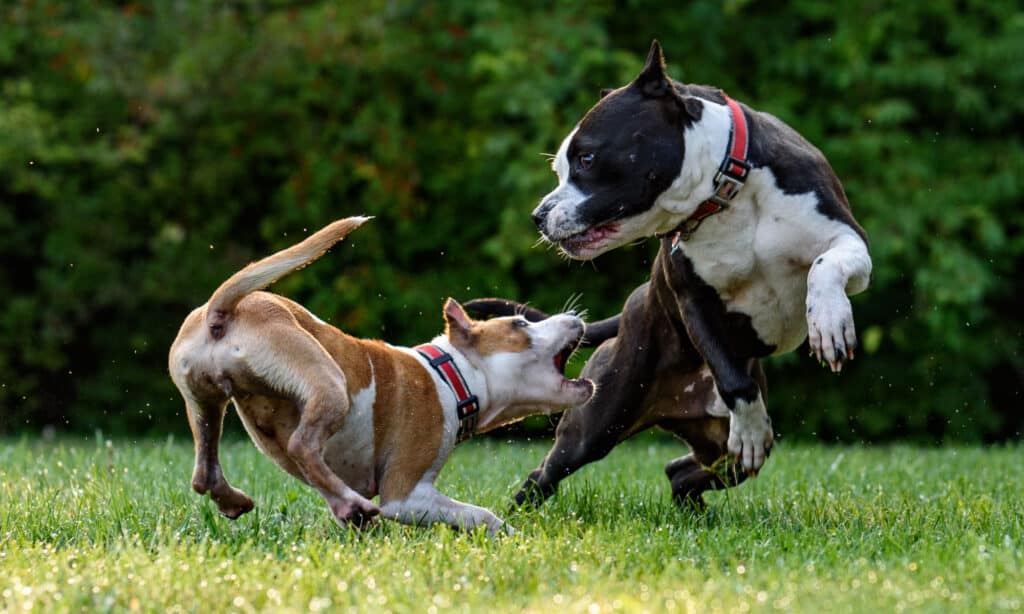
Dominance and Aggression
Dogs are social animals that have a complex social hierarchy within their own pack. This hierarchy is based on factors such as age, size, experience, and personality. Dominance is an inherent trait in some dogs that can lead to ear biting in certain situations.
Dominant dogs may use ear-biting as a way to assert their dominance over other dogs. Aggression is another factor that can cause a dog to bite another dog’s ears.
Dogs may become aggressive when they feel threatened or when they think their territory or resources are being threatened. In this case, ear biting could be a sign of aggression.
It’s important to understand the context and body language of the situation before deciding if the behavior is harmful or not. For example, if two puppies are playfully biting each other’s ears during playtime, it’s likely harmless behavior.
However, if an older dog bites an unfamiliar dog’s ears aggressively during a confrontation over resources or space, it may be a sign of aggression. In order to determine whether ear biting is harmful behavior or not, it’s important to observe the entire situation carefully.
Pay attention to both the aggressor and the receiver of the bite. Look for signs of fear or submission in the receiver such as tucked tail or lowered head. Observe dominant gestures like standing tall with ears erect and direct eye contact with the aggressor.
It should also be noted that some breeds may have stronger tendencies towards dominance or aggression than others due to genetic traits passed down through breeding. Each individual dog should still be evaluated on its own behavior before making any assumptions.

Breed tendencies
Different breeds may have different tendencies towards ear biting
When it comes to ear biting, different breeds can exhibit different levels of this behavior. Some breeds are known for playfully biting ears more than others, while some may be more prone to aggressive ear biting. For example, the Australian Cattle Dog is a breed that has been bred for herding. It uses nipping and biting as a way to control livestock.
As a result, these dogs may have a higher tendency to bite ears during play or when exhibiting dominance. On the other hand, Labrador Retrievers are known for being gentle and friendly dogs.
They are not typically bred for any specific type of work that would require ear-biting behavior. Therefore, they may be less likely to engage in this behavior.
It’s important to note that breed tendencies don’t necessarily determine whether or not a dog will exhibit ear-biting behavior. Individual temperament and training play a big role as well.
Some breeds may be more prone to playfully bite ears than others
While some breeds may be more prone to aggressive ear biting, others may be more likely to engage in playful ear-biting behavior. For example, Boxers are known for being playful and energetic dogs.
They often enjoy roughhousing with their owners or other dogs and may engage in harmless ear-biting during playtime. Similarly, Pit Bulls have historically been bred for dog fighting but many modern-day Pit Bulls are loving family pets who love playing with their humans.
Their strong jaw strength means they can easily grab an opponent’s ears without causing harm during roughhousing sessions. However, just because certain breeds are known for playful ear-biting does not mean that all individuals will exhibit this behavior equally.
Each dog is unique and their individual temperament plays a big role in how they interact with other dogs. Overall, breed tendencies can give us some insight into why dogs may engage in ear-biting behavior.
However, it’s important to remember that each dog is an individual and their personality and training also play a big role. When interacting with other dogs, it’s important to pay attention to their body language and intervene if necessary to prevent any harmful or aggressive behavior.

Preventing harmful ear biting
Tips for preventing aggressive ear biting in dogs
If your dog exhibits aggressive ear-biting behavior, it is crucial to take steps to prevent harm. The first step is to understand what triggers the behavior. Some dogs may become aggressive when they feel threatened or uncomfortable, while others may be simply playing too rough.
Here are some tips for preventing harmful ear biting:
- Supervise your dog: Always supervise your dog when they interact with other dogs or people. Keep a watchful eye on their body language and intervene if necessary.
- Distract them: If you notice your dog becoming fixated on another dog’s ears, try distracting them with a toy or treat.
- Provide enough exercise and stimulation: Make sure your dog gets enough exercise and mental stimulation to prevent boredom and restlessness that can lead to aggression.
- Socialize your dog: Socializing your dog from an early age can help reduce the likelihood of aggressive behavior towards other dogs.
- Manage their environment: If you know that certain environments or situations trigger aggression in your dog, try to avoid those circumstances as much as possible.
Training techniques to discourage harmful behavior
In addition to these tips, there are several training techniques that can help discourage harmful ear-biting behavior in dogs:
Positive reinforcement training:
This involves rewarding good behavior with treats, toys or praise. Positive reinforcement training helps establish clear communication between you and your pet while building trust and strengthening the bond between you both.
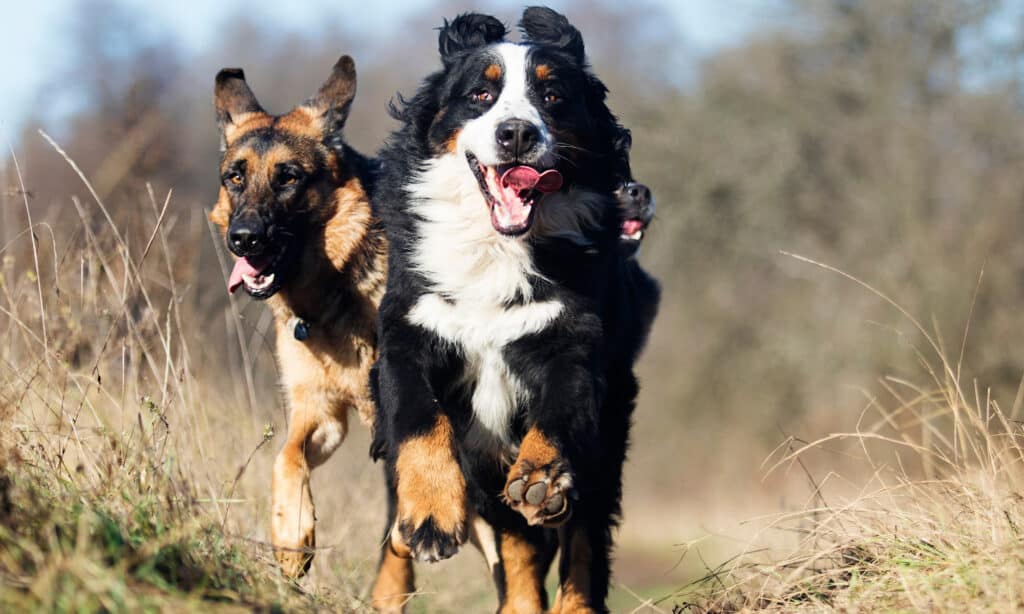
Punishment-free training:
Punishing your dog can result in fear and aggression. Instead, try to redirect their behavior with positive reinforcement training, such as using a command to stop the ear biting behavior and rewarding them when they comply.
Desensitization training:
This technique involves gradually exposing your dog to the stimulus that triggers their aggressive behavior, such as another dog’s ears. Over time, they will become desensitized to this trigger and will no longer react aggressively.
Professional behavioral training:
If you are having trouble managing your dog’s aggressive ear-biting behavior, it is essential that you seek professional advice from a certified animal trainer or veterinary behaviorist. They can help you develop an effective plan for managing your dog’s behavior and provide guidance on how to safely socialize them with other dogs.

Understanding Why Dogs Bite Each Other’s Ears
Summary of Key Points
Dogs are social animals that communicate with each other through body language, including the position and movement of their ears. Ear biting is a common behavior among dogs, and can serve different purposes depending on the context.
Playful ear biting is usually harmless and a natural part of canine play, while aggressive ear biting can be a sign of dominance or aggression. It’s important for dog owners to understand the reasons behind this behavior to prevent harmful situations and build stronger bonds with their pets.
Importance for Responsible Pet Ownership
As dog owners, it’s our responsibility to make sure our pets are happy, healthy, and safe. Understanding dog behavior is key to achieving these goals, as it allows us to interpret their needs and communicate effectively with them.
Ear biting is just one example of how dogs express themselves through body language, but there are many other behaviors that can tell us how they feel in certain situations. By observing our dogs’ body language and learning about their breed tendencies, we can prevent misunderstandings and create a trusting relationship with them.
The Role of Body Language in Dog Communication
Dogs use different parts of their bodies to communicate with each other and with humans. Their ears are particularly expressive because they can move in many directions depending on the mood or intention of the dog. For example, when a dog is relaxed or happy, its ears will be in a neutral position or slightly forward; when it’s alert or curious, its ears will be perked up; when it’s scared or submissive, its ears will be flattened against its head; when it’s aggressive or dominant, its ears may be pulled back or pinned to the side.
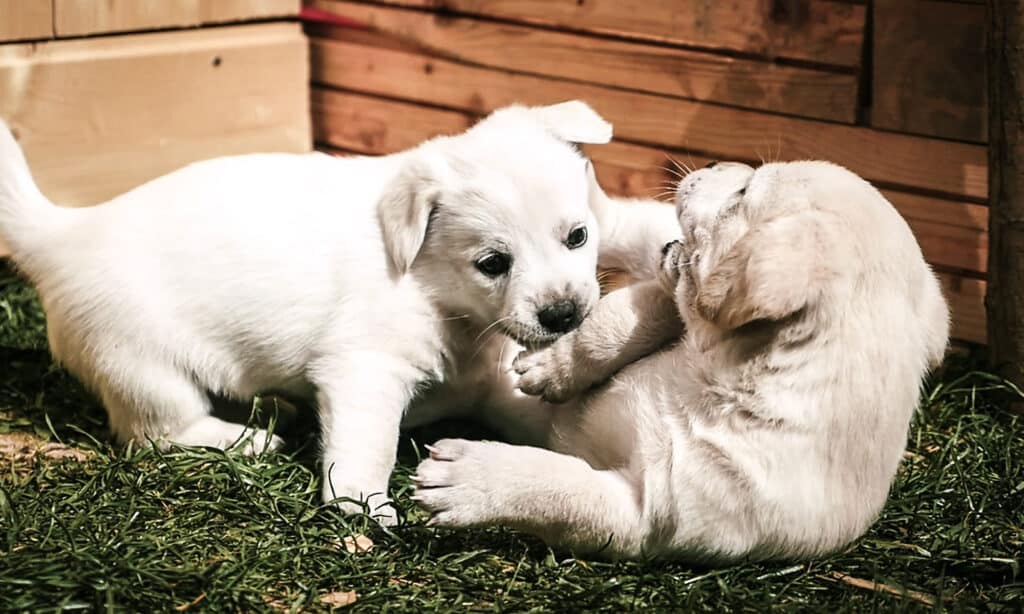
The Playful Side of Ear Biting
Playful ear biting is a common behavior among dogs, especially when they’re puppies or in a playful mood. This behavior is usually harmless and can even strengthen the bond between dogs or between a dog and its human companion.
However, it’s important to establish boundaries and teach your dog to control its bite force so that it doesn’t accidentally hurt anyone. You can also redirect this behavior by providing chew toys or other interactive toys that allow your dog to satisfy its natural urge to play.
The Dark Side of Ear Biting
Ear biting can also be a sign of aggression or dominance, especially when combined with other aggressive behaviors such as growling, snarling, or biting. In some cases, one dog may try to assert its dominance over another dog by biting its ears or neck; this can escalate into a fight if the other dog resists.
It’s important to monitor your dogs’ interactions closely and intervene if you notice any signs of aggression. You may need to separate them temporarily or seek professional help from a trainer or behaviorist.

Tips for Preventing Harmful Ear Biting
To prevent harmful ear biting and promote safe play between dogs, there are several tips you can follow:
- Socialize your dog early on so that it learns appropriate behaviors around other dogs
- Supervise your dogs’ interactions closely and intervene if necessary – Teach your dog basic obedience commands such as “sit,” “stay,” “come,” and “leave it”
- Use positive reinforcement techniques such as treats and praise to reward good behavior – Seek professional help if you’re unsure how to handle aggressive behaviors
By following these tips and being aware of the reasons behind ear-biting behavior, you can create a safe and happy environment for your furry friend. Remember that every dog is unique, so don’t hesitate to consult with a veterinarian or animal behaviorist if you have any concerns about your pet’s health or behavior.
~Lindsie
